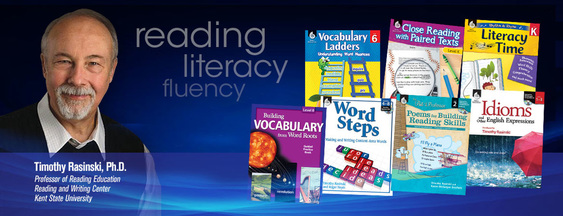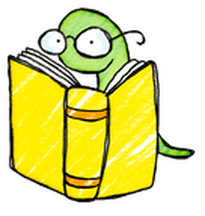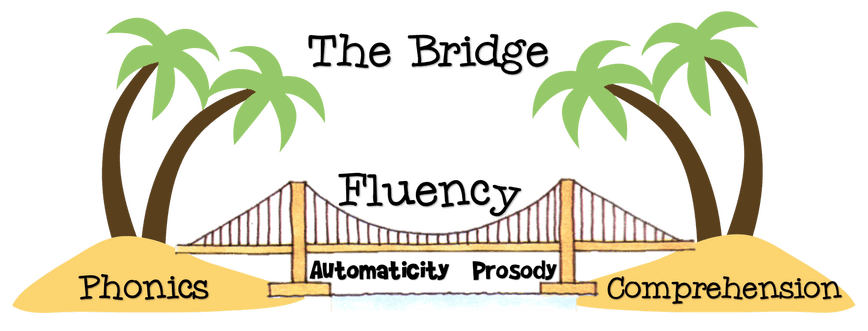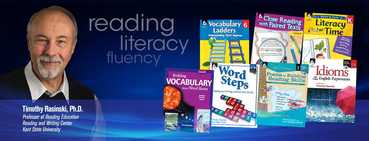 Click on link above. ~ www.timrasinski.com
Click on link above. ~ www.timrasinski.com
Dr. Timothy Rasinski is the leading expert on reading fluency. His research has brought practical wisdom to developing fluent readers in all of our students. Dr. Rasinski's recommendations are easy to implement in any classroom or intervention group.
This page is focused on sharing his practical advice on building fluent readers.
This page is focused on sharing his practical advice on building fluent readers.

What is reading fluency?
Fluency is not just speed or rate of reading a text. It is the ability to read text accurately, quickly, effortlessly, and with expression (prosody), so the reader can comprehend. Fluency is the bridge between decoding and comprehending text. Our goal should be to help our students read accurately and automatically, so that the brain can focus its energy on why we read ~ to comprehend the author's message.
Fluency is not just speed or rate of reading a text. It is the ability to read text accurately, quickly, effortlessly, and with expression (prosody), so the reader can comprehend. Fluency is the bridge between decoding and comprehending text. Our goal should be to help our students read accurately and automatically, so that the brain can focus its energy on why we read ~ to comprehend the author's message.
| article_why_fluency_shd_be_hot__rt_may_2012.pdf | |
| File Size: | 242 kb |
| File Type: | |
How do I plan for fluency instruction?
~Dr. Tim Rasinski
Part 1 ~ Text Mastery
*Model, Phrasing, Repeated Readings
Part 2 ~ Word Study
*Word Harvest
Part 3 ~ Home Reading
*Same text from the classroom/repeated readings
~Dr. Tim Rasinski
Part 1 ~ Text Mastery
*Model, Phrasing, Repeated Readings
Part 2 ~ Word Study
*Word Harvest
Part 3 ~ Home Reading
*Same text from the classroom/repeated readings
| building_fluency_through_the_phrased_text_lesson_article.pdf | |
| File Size: | 151 kb |
| File Type: | |
| ira07tim_rasinski_2__1_.pdf FDL p. 15 | |
| File Size: | 7048 kb |
| File Type: | |
| word_harvesting_article.pdf | |
| File Size: | 308 kb |
| File Type: | |
|
|
|

What should I focus on during fluency instruction?
Model Fluent Reading Daily:
1. Focus on prosody (expression) as teacher models
2. Use poems, songs, short text to model fluency
Assisted Reading:
1. Choral Reading
2. Echo Reading
3. Paired Reading
4. Technology Assisted Reading
5. Captioned Television
Repeated Readings:
1. Repeated Readings of poems, songs, plays
a. Word Harvest/Study
b. Comprehension Focus
c. Student must track text
2. Sight Words ~ Mastering Automaticity
Phrasing:
1. Teacher pre-marks phrase boundary lines
2. Model reading in meaningful phrases
3. Attending to punctuation
4. Sight word phrase card practice
Model Fluent Reading Daily:
1. Focus on prosody (expression) as teacher models
2. Use poems, songs, short text to model fluency
Assisted Reading:
1. Choral Reading
2. Echo Reading
3. Paired Reading
4. Technology Assisted Reading
5. Captioned Television
Repeated Readings:
1. Repeated Readings of poems, songs, plays
a. Word Harvest/Study
b. Comprehension Focus
c. Student must track text
2. Sight Words ~ Mastering Automaticity
Phrasing:
1. Teacher pre-marks phrase boundary lines
2. Model reading in meaningful phrases
3. Attending to punctuation
4. Sight word phrase card practice
| fluency_strategies-with_answers__1_.pdf | |
| File Size: | 38 kb |
| File Type: | |
| phrased_reading.pdf | |
| File Size: | 279 kb |
| File Type: | |




























